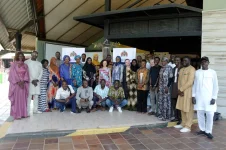The Ministry of Justice and the International Coalition of Sites of Conscience (ICSC) held a training in December 2024. It was for the committees working on a plan to remember victims after the Truth, Reconciliation, and Reparations Commission (TRRC). The training lasted a week. It took place at the Senegambia Hotel in Kololi.
The committee members really liked the training. They said it taught them a lot and will help them in their work. The trainers were Gegê Leme Joseph, Devon Gulbraudsen, and Cate Turner from ICSC. The members are glad they can keep getting advice from these experts.
The training aimed to help the committees create a coordinated plan to honor victims. Participants learned about the theory and practice of memorialization, which means preserving memories. They reviewed findings from community meetings and learned what a memorialization strategy can and cannot do.
The five-day training covered many topics, including how memorialization relates to justice after conflict, how it can help people heal, and how it can prevent violence. The trainers shared best practices and challenges. The group studied real examples and made plans for memorialization activities.
Memorialization is about keeping memories alive over time. It involves how we remember people and events as a society. Personal memories are a person's own experiences. They help connect people who went through similar things. Group memories create a shared story. This can heal wounds and stop terrible things from happening again. It also tells of struggles and successes.
The trainers said memorialization builds shared stories for communities. In divided societies, it must include different views and consider the needs of marginalized groups.
Memorialization is a form of truth-telling. It can publicly recognize victims and abuses, helping society heal and reconcile. It can also build support for broader truth and justice efforts, push for reforms, and teach future generations about human rights.
Memorialization projects can encourage respect for rights, build empathy, and help us learn from the past to prevent violence. However, memorials do not always promote human rights. They can celebrate one group's power over another. Abusive governments may use them to justify violence and spread false history.
Memorialization faces challenges. Survivors may not feel safe sharing their stories during conflict, and memorialization might seem less important in wartime. There may also be limited ability to do this work during fighting.
Gegê Leme Joseph talked about why memorialization matters to communities. She focused on its link to truth-telling and truth commissions. Memorialization combines truth, trials, reforms, and repair. She quoted an archbishop who said society cannot have peace without facing the past.
Truth-telling happens when people share stories. There are different types of truth in memorialization: factual, social, personal, and healing truths.
Memorialization is the fifth part of transitional justice. It saves history, honors victims, helps healing, teaches prevention, and builds unity. Before truth commissions, it saves local stories, raises awareness, and empowers communities.
During truth commissions, memorialization should enable testimony and inclusion. It should highlight structural wrongs and combine justice and healing. After commissions, it keeps the memory alive. It stops denial, builds strength, and supports long-term reconciliation.
The committee members really liked the training. They said it taught them a lot and will help them in their work. The trainers were Gegê Leme Joseph, Devon Gulbraudsen, and Cate Turner from ICSC. The members are glad they can keep getting advice from these experts.
The training aimed to help the committees create a coordinated plan to honor victims. Participants learned about the theory and practice of memorialization, which means preserving memories. They reviewed findings from community meetings and learned what a memorialization strategy can and cannot do.
The five-day training covered many topics, including how memorialization relates to justice after conflict, how it can help people heal, and how it can prevent violence. The trainers shared best practices and challenges. The group studied real examples and made plans for memorialization activities.
Memorialization is about keeping memories alive over time. It involves how we remember people and events as a society. Personal memories are a person's own experiences. They help connect people who went through similar things. Group memories create a shared story. This can heal wounds and stop terrible things from happening again. It also tells of struggles and successes.
The trainers said memorialization builds shared stories for communities. In divided societies, it must include different views and consider the needs of marginalized groups.
Memorialization is a form of truth-telling. It can publicly recognize victims and abuses, helping society heal and reconcile. It can also build support for broader truth and justice efforts, push for reforms, and teach future generations about human rights.
Memorialization projects can encourage respect for rights, build empathy, and help us learn from the past to prevent violence. However, memorials do not always promote human rights. They can celebrate one group's power over another. Abusive governments may use them to justify violence and spread false history.
Memorialization faces challenges. Survivors may not feel safe sharing their stories during conflict, and memorialization might seem less important in wartime. There may also be limited ability to do this work during fighting.
Gegê Leme Joseph talked about why memorialization matters to communities. She focused on its link to truth-telling and truth commissions. Memorialization combines truth, trials, reforms, and repair. She quoted an archbishop who said society cannot have peace without facing the past.
Truth-telling happens when people share stories. There are different types of truth in memorialization: factual, social, personal, and healing truths.
Memorialization is the fifth part of transitional justice. It saves history, honors victims, helps healing, teaches prevention, and builds unity. Before truth commissions, it saves local stories, raises awareness, and empowers communities.
During truth commissions, memorialization should enable testimony and inclusion. It should highlight structural wrongs and combine justice and healing. After commissions, it keeps the memory alive. It stops denial, builds strength, and supports long-term reconciliation.












